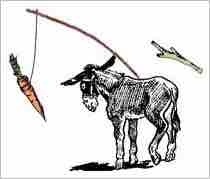An incentive system is a business management tool that introduces a structured motivation system to promote desired employee behaviors. Human resources (HR) professionals are tasked with using employee and organizational objectives to identify and implement the best employee incentive programs.
How Incentives Improve Performance
To be effective, incentive systems must address employee skills and motivation, acknowledgement of employee successes, a clearly-defined set of goals, and a means for assessing progress. These systems must also be tailored to the needs of the organization. Incentive systems are often implemented to prevent and overcome poor performance, failure to meet organizational goals, poor morale, increased turnover, and the stress of increased demands on employees.

Carrot and stick
Incentive systems should use the carrot (reward) as opposed to the stick (punishment) to motivate employees.
Incentive systems are grounded in the idea that employee effort increases as workers perceive that they are making progress towards reaching set goals. A successful system promotes full employee participation by offering a wide array of rewards and keeping employees motivated to participate.
The Role of Human Resources
Incentive systems only work when they are closely tailored to the goals of the organization. The system's goals must be challenging but attainable, or employees will not be motivated to participate. It's counter-intuitive, but research has shown that monetary rewards are ineffective incentives. One incumbent risk of incentive systems is the moral hazard of encouraging individuals to achieve their own goals and specific targets rather than improving upon organizational performance as a whole.
Human resources departments must identify the core culture of the organization and create incentives that match it. For example, a company built on innovation must inspire risk-taking without any guarantees of success. This means performance incentives and metrics may be relatively useless (and most likely damaging) to executing the core organizational goals. Instead, HR could provide incentives like telecommuting or the freedom to devote a percentage of each work day to independent projects (Google does this).
At the other end of the spectrum, Walmart promotes rigidly controlled operational efficiency. To reduce employee errors, an incentives system could reward efficiency. The most consistent truck drivers, for example, could receive a reward for their clockwork performance.